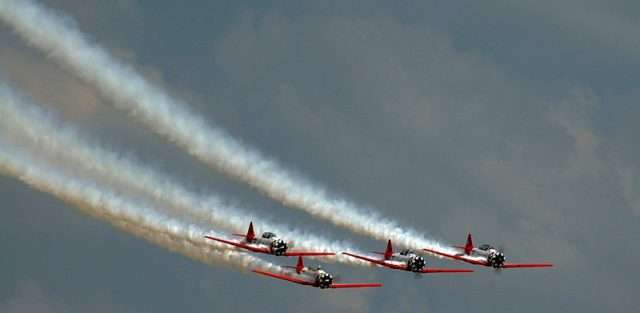Contrail Streaks

Contrail streaks, also known as condensation trails, are produced by an aircraft’s engine exhaust. Some people even refer to these trails as a jet stream; however, that term isn’t really correct. A jet stream is more commonly known as a strip of air containing strong winds that can influence aircraft and climate.
What Causes Contrail Streaks?
Contrail streaks occur when the hot exhaust from an aircraft mix with cooler air. It’s very similar to the way you can see your breath during a chilly day. Because aircraft fly at high altitudes where the air is typically much cooler, contrails are a fairly regular occurrence.
What do Contrail Streaks Contain?
Contrail streaks are made up of:
- Carbon dioxide
- Sulfur oxide
- Nitrogen oxide
- Unburned fuel
- Soot
- Metal particles
- Water vapor
When the gases mix together, the contrail will rotate with respect to the ambient air. The regions of rotating air are known as vortices. The vortices will then merge together and form the streaks you commonly see overhead.
Contrail Streaks vs. the Environment
Research recently conducted argues that contrails cause greenhouse effects and contribute to global warming. Because of the popularity and frequency of aircraft flights, this issue has been gaining traction among the world population. Some researchers have even argued that contrails are so packed full of chemical pollutants that they can affect a person’s health if overexposed.
Contrail streaks, also known as condensation trails, are produced by an aircraft’s engine exhaust. Some people even refer to these trails as a jet stream; however, that term isn’t really correct. A jet stream is more commonly known as a strip of air containing strong winds that can influence aircraft and climate.
What Causes Contrail Streaks?
Contrail streaks occur when the hot exhaust from an aircraft mix with cooler air. It’s very similar to the way you can see your breath during a chilly day. Because aircraft fly at high altitudes where the air is typically much cooler, contrails are a fairly regular occurrence.
What do Contrail Streaks Contain?
Contrail streaks are made up of:
- Carbon dioxide
- Sulfur oxide
- Nitrogen oxide
- Unburned fuel
- Soot
- Metal particles
- Water vapor
When the gases mix together, the contrail will rotate with respect to the ambient air. The regions of rotating air are known as vortices. The vortices will then merge together and form the streaks you commonly see overhead.
Contrail Streaks vs. the Environment
Research recently conducted argues that contrails cause greenhouse effects and contribute to global warming. Because of the popularity and frequency of aircraft flights, this issue has been gaining traction among the world population. Some researchers have even argued that contrails are so packed full of chemical pollutants that they can affect a person’s health if overexposed.








